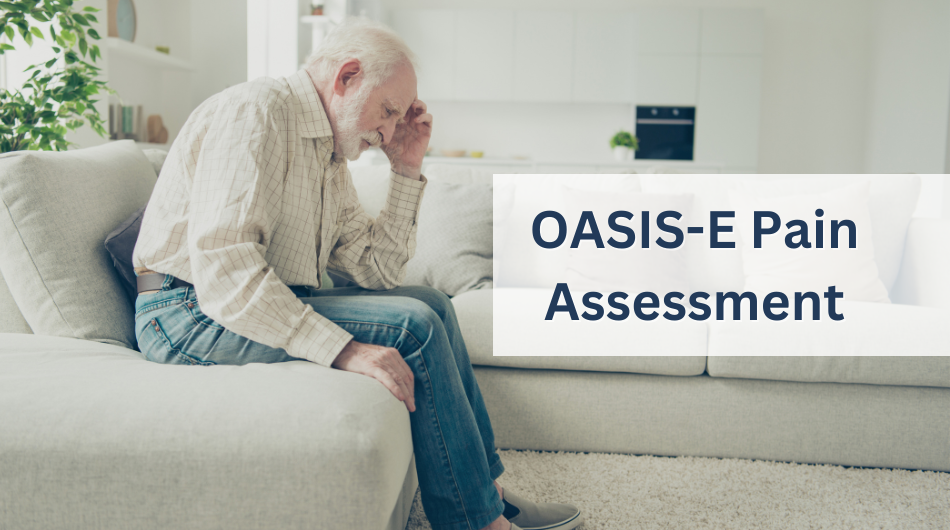OASIS Item M1242, which assesses the frequency at which a patient’s pain interferes with activity, was retired on January 1, 2023. Pain is now assessed more thoroughly on the new OASIS E and is broken down to assess how pain impacts three specific activities which include:
- J0510-How pain impacts sleep
- J0520-How pain interferes with therapy activities
- J0530-How pain interferes with day-to-day activities.
Documenting Pain
When documenting pain, clinicians must remember that pain is subjective. It is whatever the patient says it is and exists whenever they say it does. By targeting how pain impacts these specific scenarios, versus how it impacts activity in general, clinicians will better be able to determine what modifications need to be made to improve patient outcomes and quality of life.
Frequency of pain
The “all of the time” response that was on the prior OASIS D-1 seemed to cause a lot of confusion because patients would report constant pain, but inconsistencies arose when the patient would also report that pain did not interfere with sleep. This is likely why the “all of the time” response is no longer an option on the new OASIS E. The clinician will now document whether the patient experienced no pain related to any of the above situations or if they experienced pain rarely, occasionally, frequently, or almost constantly. For patients who are unable to respond, there is now an option which allows this to be documented.
A well defined look-back period for pain
Guidance related to the OASIS E pain assessment also specifies that the look-back period for assessing pain is 5 days and that if a patient can’t decide between two frequencies then the clinician should choose the higher score. These overall changes make it so that a clinician can now be more specific and feel confident when scoring a patient’s pain. Let’s take a look at why it is so important to assess the impact of pain on these specific activities.
J0510 Pain impact on sleep
Pain that impacts a person’s sleep is directly related to poor outcomes. How the two conditions are related varies from person to person, but typically if pain is not well controlled, it can result in chronic exhaustion which studies show can intensify pain. This can land patients in a vicious cycle, and impact their overall well being. It is important that clinicians assess how a patient’s sleep is impacted by their pain as well as what they are doing to manage the problem. The goal is to be sure patients are managing their pain properly.
J0520 Pain interference with therapy activities
Before assessing how pain interferes with therapy, let’s be sure everyone understands what CMS means when they use the term therapy. Rehabilitation therapy is special healthcare services/programs that help a person regain physical, mental, and/or cognitive abilities that have been lost or impaired as a result of disease, injury, or treatment. These services can include, but are not limited to: Physical Therapy, Occupational Therapy, Speech Therapy, and Cardiac & Pulmonary Therapy. Treatment that needs to be considered when assessing the impact of pain, can be supervised in person by a therapist, nurse, or other staff OR can include a prescribed therapy program carried out by a patient/family/caregiver without agency staff present. This item is not applicable if the patient has not participated in therapy in the past 5 days; otherwise, the response options mentioned earlier would be applied here as well.
J0530 Pain interference with day-to-day activities
Day-to-day activities are things that happen or exist as part of a patient’s everyday routine while they go about their ordinary life. These can include activities related to household chores, eating, personal care, creative activities, reading, and puzzles, as well as physical, social, and spiritual activities. The list is endless because day-to-day activities will vary from patient to patient, and any pain that prevents a patient from participation should be assessed and addressed.
Are dashes a valid response?
For the three items above, a dash is not a valid response because these items are scored based on the patient’s interpretation of the provided frequency options. It is important to be sure that the patient understands that this item excludes activities related to therapy, and that NA is not an option because every patient has to perform, or gets assistance performing, some degree of day-to-day activities, and these activities either are or aren’t impacted by pain.
Pain is personal
Pain can also be a very personal subject. It’s not uncommon for the older generations to internalize pain and avoid verbalizing their discomfort. Oftentimes rather than asking how their pain level rates, it is better to ask if there are any particular activities that hurt to perform, or how often they experience aching or burning after activities. Determining whether pain is localized/generalized, acute/chronic, continuous/intermittent, or directly related to a specific activity is vital to know so that the appropriate pain management strategies can be put into place to improve a patient’s outcomes.
PQRST Pain Assessment Method
Since pain is subjective, and often personal, self-report is considered the Gold Standard and most accurate measure of pain. When scoring the OASIS clinicians do not want to offer a predetermined response or provide any interpretation of how a patient reports their pain, but the following method can aid in helping evaluate a patient’s response to treatment and assist in developing intervention on the plan of care to address pain so that it is patient specific simply by asking the following questions:
P=Provocation/Palliation
What were you doing when the pain started? What caused it? What makes it better or worse?
What relieves it? Medications, heat/cold, changing position, resting?
What aggravates it? Movement, bending, lying down, walking, standing?
Q=Quality/Quantity
What does it feel like? Would you describe the pain as sharp, dull, stabbing, burning, throbbing, nauseating, shooting?
R = Region/Radiation
Where is the pain located? Does it feel like it travels/moves around? Did it start elsewhere and is now localized to one spot?
S = Severity Scale
How severe is the pain on a scale of 0 to 10, with zero being no pain and 10 being the worst pain you have ever had? How bad is it at its worst? How long does an episode last?
T = Timing
Have you experienced pain in the past 5 days? How often does it occur: hourly? daily? weekly? monthly? Is it sudden or gradual? When do you usually experience it: daytime? night? early morning? Is it accompanied by other signs and symptoms?
Documentation is vital
Performing an accurate pain assessment is equally necessary to accurate documentation. Both of these are best practices and will guarantee that patients receive the highest quality pain management. In addition, reassessment plays a major role in determining how the quality of care provided leads to positive outcomes, when the patient shows improvement over time. Improvement is the ultimate goal.


